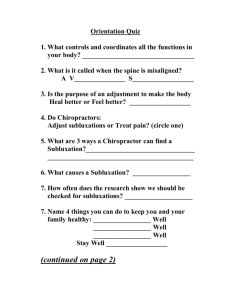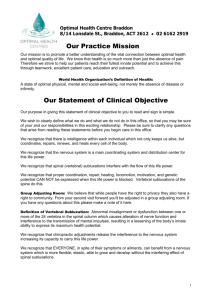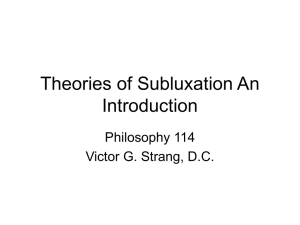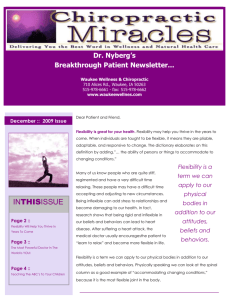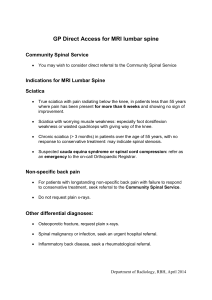What is a Subluxation - Robina Town Chiropractic
advertisement
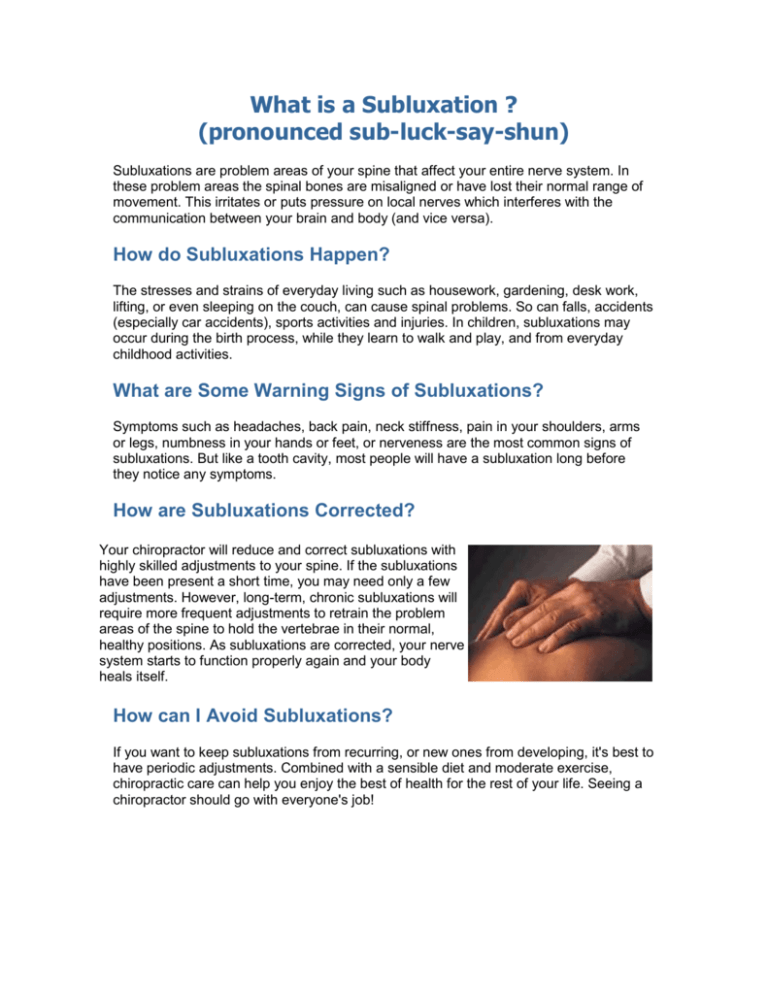
What is a Subluxation ?
(pronounced sub-luck-say-shun)
Subluxations are problem areas of your spine that affect your entire nerve system. In
these problem areas the spinal bones are misaligned or have lost their normal range of
movement. This irritates or puts pressure on local nerves which interferes with the
communication between your brain and body (and vice versa).
How do Subluxations Happen?
The stresses and strains of everyday living such as housework, gardening, desk work,
lifting, or even sleeping on the couch, can cause spinal problems. So can falls, accidents
(especially car accidents), sports activities and injuries. In children, subluxations may
occur during the birth process, while they learn to walk and play, and from everyday
childhood activities.
What are Some Warning Signs of Subluxations?
Symptoms such as headaches, back pain, neck stiffness, pain in your shoulders, arms
or legs, numbness in your hands or feet, or nerveness are the most common signs of
subluxations. But like a tooth cavity, most people will have a subluxation long before
they notice any symptoms.
How are Subluxations Corrected?
Your chiropractor will reduce and correct subluxations with
highly skilled adjustments to your spine. If the subluxations
have been present a short time, you may need only a few
adjustments. However, long-term, chronic subluxations will
require more frequent adjustments to retrain the problem
areas of the spine to hold the vertebrae in their normal,
healthy positions. As subluxations are corrected, your nerve
system starts to function properly again and your body
heals itself.
How can I Avoid Subluxations?
If you want to keep subluxations from recurring, or new ones from developing, it's best to
have periodic adjustments. Combined with a sensible diet and moderate exercise,
chiropractic care can help you enjoy the best of health for the rest of your life. Seeing a
chiropractor should go with everyone's job!
Subluxations prevent you from enjoying
the best of health. Only a chiropractor
is trained to correct them.
Vertebral Subluxation Complex (VSC)
Introduction
The brain stem and spinal cord are the primary pathways for nerve impulses to and from
the brain. Messages back and forth through these nerves control the health and function
of virtually every other cell, tissue, organ, and system of the body.
Nerve tissue is so important, it is protected by bone. The brain is encased by the skull,
and the spinal cord is covered by 24 moving bones of the spinal column.
Many everyday things can cause these bones to lose their normal motion or position.
This sets off a chain reaction affecting the spinal bones, nerves, muscles, soft tissues,
and results in degenerative changes throughout the body. Doctors of Chiropractic refer
to this as the Vertebral Subluxation Complex.
Besides describing how the spine can affect your overall health, the Vertebral
Subluxation Complex explains why it takes time to restore optimum health. The
Vertebral Subluxation Complex is the underlying cause of many health problems and is
recognized by its five component parts:
Spinal Kinesiopathology
Neuropathophysiology
Myopathology
Histopathology
Pathophysiology
Spinal Kinesiopathology - abnormal motion of the spinal
bones.
The bones of the spine are designed to move and protect the delicate spinal cord
and nerve roots. But, sometimes their movement is altered, they either become
stuck or start moving too much.
Abnormal spinal movement is can be caused by physical trauma (repetive
motion, car accidents, slips, falls, improper lifting, poor sleeping habits),
emotional stress (worry, negative thoughts, fear), or chemical imbalances
(alcohol, drugs, toxins, pollutions.)
When spinal joints are fixated ('stuck'), other joints must compensate and move
too much. This results in distorted normal spinal curves and compromises
proper function, causes problems in other areas of the spine.
Doctors of Chiropractic can detect this aspect of the Vertebral Subluxation
Complex by analyzing your posture, taking diagnostic X-rays, measuring your
ability to turn and bend, plus other tests.
The primarily effect of the spinal adjustment is to restore proper spinal
motion.
Neuropathophysiology - abnormal nerve system function
Because of the way your spine is designed, abnormal spinal function can rub,
pinch, or irritate the delicate tissues of the spinal cord and nerve roots. While
commonly associated with spinal problems, an actual pinched nerve is quite
rare. It is estimated that only 10-15% of spinal-related problems are caused by
direct pressure of bone on nerve tissue.
Nerve tissue irritation can result in numbness, burning, or a 'pins and needles'
feeling. This nerve system impairment can affect the tissues, organs, and other
systems of the body, increasing the susceptibility of disease and ill health.
When the communication lines from the brain to the rest of the body
are not functioning properly, you can suffer from hypertension, indigestion,
pain, and numbness.
Myopathology - abnormal muscle function
When spinal joints stop moving properly, muscles have to work much harder to
control your spine's movements. As a result some muscles will atrophy (waste
away) while others are forced to work harder and go into spasms.
In chronic or long standing cases scar tissue can form in these muscles,
changing their ability to work. This damage to the supporting muscles of the
spine is why repeated adjustments are often necessary and adjustments don't
seem to 'hold.' It also explains why long-standing spinal problems are so difficult
and time-consuming to correct. Without proper rehabilitation, many patients
experience a relapse of their original health complaint.
The spinal muscles are the guide wires that support the spine. If they can't
work properly, the result will be chronic pain, muscle fatigue and swelling.
Histopathology - abnormal soft tissue function
When there is spinal joint malfunction, the discs, ligaments, and other connective
tissue are also affected.
While technically you can't have a 'slipped' disc, the soft pulpy discs that
separate each spinal vertebrae can tear, bulge, herniate, and degenerate.
Ligaments and other connective tissues in the area of the malfunctioning spinal
joint are often involved. Inflammation and swelling accompany the accumulation
of blood and lymph, causing a rise in temperature.
Unlike most other tissues of the body, discs and ligaments have a poor blood
supply. This makes the healing of soft tissues a very slow and time-consuming
process.
In fact, complete healing often requires continued care even after the relief of
obvious symptoms.
Ligaments, tendons and spinal discs have a poor blood supply and heal
slowly.
This is why proper nutrition, rest and repeated spinal adjustments are
needed to completely
eliminate the cause of your pain.
Pathophysiology - abnormal function of the spine and
body
When there is malfunction or trauma to a joint, one of the ways the body
responds is to stabilize the area by growing new bone.
Over time, boney deposits can build up, eventually recognizable as bone spurs
growing from your spine. This arthritic 'splinting' of adjacent bones is nature's
attempt to stabilize the malfunctioning joint. If ignored or neglected long enough,
the body can turn a once mobile joint into one solid bone.
Throughout the body, degenerative changes can be seen in other organs and
systems. Many health conditions not normally considered related to 'back
problems,' can often be traced back to the nerve system impairment by the spine.
While often seen in the aged, this degenerative condition is not part of the normal
aging process. This type of spinal decay is the result of spinal problems which
have been ignored or neglected for many years.
If your spinal joints are not moving properly,
degeneration of your spine and health will be the result.
What Causes A Subluxation ?
Automobile Accidents
Emotional Stress
Improper Lifting
Alcohol
Chemical Imbalances
Long periods of sitting
Poor Posture
Poor Ergonomics
Car Accidents / Falls
The primary job of the Doctor of Chiropractic is to detect, correct and help prevent the
Vertebral Subluxation Complex using Chiropractic spinal manipulation (the Adjustment)
as the primary form of treatment. Applying a carefully and precisely directed force
exerted by his or her hands to the spine, the Doctor of Chiropractic is able to restore
normal motion and function to the spine, thereby reducing or eliminating the Vertebral
Subluxation Complex.
Subluxations prevent you from enjoying the best of health.
Your chiropractor is a specialist in the detection and prevention of the
Vertebral Subluxation Complex.
How do Subluxations affect my health?
It is known that every cell in your body is controlled by your nerve system. It is also
known that stress on the spinal joints or structures results in interference in the
functioning of the spinal nerves. Thus when your spine is subluxated the nerves will
suffer and ultimately the organs or tissues that the nerves supply will also suffer.
The animation below shows 3 different stages of spinal functioning.
1. The green dot represents ideal spinal functioning, and the nerves fire at a
normal, controlled and calm rate. In this stage the brain is able to get clear,
accurate signals from the organs and is able to respond appropriately to ensure
your body is working as close to optimal as possible.
2. In a 'sub optimal state' the spine isn't quite 100%, and neither are the nerves.
Often you are no longer in pain, but since only 10% of your nerves carry pain,
you are often not aware that the organs are also not functioning at 100%.
3. In the subluxated state, there is so much chaos in your spine and nerve system
that the nerves are unable to send or receive accurate information to and from
the brain. As a result you will experience pain, discomfort, headaches, back pain
and other obvious symptoms.
Chiropractors do not consider a lack of pain to be a key marker in your state of health.
Chiropractors look at how well you function as an indicator of your state of health. For
instance top athletes often don't have pain, but demand more from their body, hence
they seek Chiropractic care to ensure their spine and nerve system are working
optimally.
Many of us are completely unaware of the millions of processes occurring in our body
every day. For instance most people are not aware of their heart beating or their
stomach working - your body takes care of all that for you. Thus wouldn't you want to
make sure the communication lines from your organs to your brain are working at
100%?
